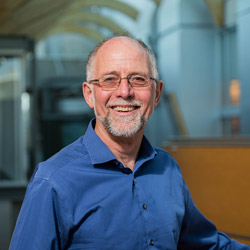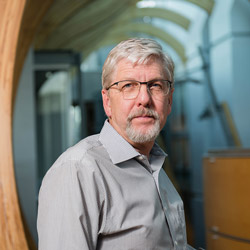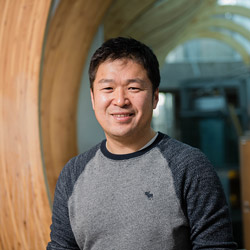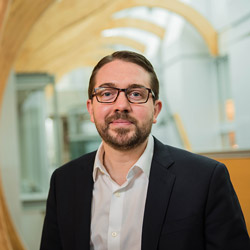Awards and recognition
Four Faculty members receive CIHR Foundation Grants
The Michael Smith Lab congratulates four Faculty members who received Foundation Grants in the 2015-2016 Canadian Institutes of Health Research (CIHR) competition. Investigators Steve Withers ($1,495,089) and Phil Hieter ($2,526,307) receive funds for 7 years and were part of the 87 successful applications out of 645 total for the mid-career/senior investigator cohort. Also, Nobu Tokuriki ($1,057,965) and Christian Kastrup ($1,377,460) receive funds for 5 years, they were among the 33 of 265 submitted applications who were funded in the new/early career investigators cohort, defined as researchers within the first 5 years of their independent career.
These Foundation grants are designed to contribute to a sustainable foundation of new and established health research leaders, by providing long-term support for the pursuit of innovative and high-impact research programs. Foundation grants:
- Support a broad base of health research leaders across all career stages, areas, and health-related disciplines with a demonstrable track record of excellence and impact in their field of study;
- Develops and maintains Canadian capacity in health research and other related fields;
- Provide research leaders with the flexibility to pursue novel and innovative lines of inquiry;
- Contribute to the creation and application of health-related knowledge through a wide range of research and/or knowledge translation activities, including relevant collaboration
 Steve Withers
Steve Withers
Project title: Towards new therapeutics through manipulation of glyco-enzymes
Abstract: The surfaces of every cell in the human body are coated with specific sugars. These play several roles, principally providing a way for the cell to interact with other cells and their components. Invading bacteria and viruses also use these sugars as an entry point, thus an understanding of these interactions and of how the specific sugars are built and degraded, can lead to new therapeutics. An example is the influenza virus drug Tamiflu, which blocks the critical viral enzyme that cuts a sugar off our cell surfaces and allows the virus to spread. Our recent research has shown that some of the enzymes used by disease-causing bacteria and parasites in order to infect human cells are unlike any enzymes present in human cells. This allows us to design and synthesize new classes of drug to either specifically block these enzymes, as with Tamiflu, or to liberate toxins specifically within the invader. Using such approaches, in collaboration with microbiologists, we shall develop new strategies for treatment of antibiotic-resistant bacteria, as well as the parasites that cause Chagas disease in South America. In a second part of our work we shall use enzymes to modify these cell surface sugars for a variety of applications. In one case we use enzymes to cut specific sugars off the surface of red blood cells, thereby changing their blood type from A or B (or AB) to the “universal donor” Type O. Using an approach that mimics the process of natural evolution, but accelerates it, we shall engineer these enzymes to speed them up for clinical use. This work should greatly improve our supply of blood for transfusions. In a second case we shall use enzymes to improve the performance of increasingly important protein-based drugs such as antibodies and growth factors. Most such proteins have sugars on their surface that play important roles. We shall engineer enzymes to add sugars in a highly controlled manner, yielding drugs of improved performance.
 Phil Hieter
Phil Hieter
Project title: Chromosome instability and synthetic lethality in yeast and cancer
Abstract: Effective cancer therapy exploits specific biological differences between cancer cells and normal cells. Cancer cells often have defects that reduce the efficiency of chromosome transmission. Indeed, mutations in cancer cells that cause chromosome instability (CIN) are now widely recognized to be an important driver in cancer initiation and progression. These CIN mutations also represent tumour specific genetic vulnerabilities that could be exploited in developing new cancer treatments. Because the same building blocks are used to construct organisms as diverse as yeast, worms, and humans, “model organisms” provide powerful experimental tools for investigating the mechanistic basis of disease and for developing potential therapeutic interventions. The goals of our work are to understand the mechanisms of chromosome transmission at the levels of genes, pathways, and networks using yeast and the nematode worm as models, and to directly relate our studies to cancer and the development of new cancer therapies. Using yeast genetic techniques, in particular, global synthetic lethality analysis, we will identify yeast genes, and the corresponding human gene counterparts, that define potential therapeutic targets for selective killing of cancer cells relative to normal cells. We will use yeast to rapidly test millions of possible combinations of tumour-associated defects, drug targets, and chemotherapeutic agents to identify effective combinations, and will prioritize them for further testing in tumour cell cultures. The results of our proposed research will provide a basic understanding of the mechanisms of normal chromosome transmission, and of the corresponding defects associated with cancer pathology. Our results will also lead to the identification of new drug targets and will enable the identification of new small molecule inhibitors and combination therapies that could be used for the selective killing of cancer cells in patients.
 Nobu Tokuriki
Nobu Tokuriki
Project title: Evolutionary approaches to treat and evade antibiotic resistant pathogenic bacteria
Abstract: Bacterial infections are major threats to human health. In the last century, antibiotics have served as our arsenals to fight bacterial infections. However, unfortunately, bacteria have since evolved resistance against virtually all known antibiotics, in several cases only a few years after a new antibiotic was introduced. We therefore urgently need to develop novel strategies if we are to prevent the spread of antibiotic resistance, and to discover sustainable antibiotic reagents (i.e. for which resistance cannot easily evolve). I envision that I will lead the field to pioneer new antibiotic strategies to improve our healthcare system by employing “evolutionary approaches” to predict and prevent the evolution of antibiotic resistance. First, I will establish a platform to examine evolutionary potential and limit of antibiotic resistance using experimental evolution in the laboratory. Second, using laboratory evolution and engineering, I will generate novel anti-virulence reagents, e.g. enzymes to degrade cell-to-cell signaling molecules and therefore inhibit biofilm formation. Targeting such molecules is a potentially sustainable antibiotic strategy as it is unlikely that bacteria can easily evolve resistance. My research program will create powerful new approaches and tools to combat multi-drug resistant pathogenic bacteria. My strong expertise in laboratory evolution and engineering, and established collaborations with structural biologists, microbiologists and computational biologists will enable me to effectively tackle this challenge. My CIHR Foundation program will lead us to the development of novel antibiotic strategies and reagents to battle against antibiotic-resistant pathogenic bacteria.
 Christian Kastrup
Christian Kastrup
Project title: Materials and Mechanisms for Understanding and Controlling Hemorrhage
Abstract: Uncontrolled bleeding is a leading cause of death in Canada and worldwide, particularly in young healthy adults. While there are a range of therapies for stopping blood flow, they are still ineffective in the most severe cases of hemorrhage. My research program aims to develop new therapeutics that can be used in severe bleeding, by exploring novel mechanisms that could explain why current therapeutics are ineffective in these scenarios. Specifically, we will investigate three possible approaches; 1) Improve the penetration of blood clotting agents to wounds using delivery vehicles that can move against blood flow, which otherwise washes away factors that promote clotting, 2) Increase the ability of platelets to induce clotting, as these cell are first-wave responders that naturally help blood clot, and 3) Increase the strength by which blood clots adhere to injured blood vessels. Each strategy is based on biochemical insights and drug delivery techniques that my lab has already developed, and the research program will focus on applying these techniques to understanding and treating severe bleeding. My lab is uniquely poised to address this issue due to our extensive experience in both blood biochemistry and biomedical engineering, as well as the extensive support we have received from clinicians and the industry, which will allow us to translate laboratory findings into the clinic. The short-term goal of this program is to identify limiting factors that prevent the successful treatment of severe bleeding with current therapeutics, and then use these insights to develop novel technologies that enhance blood clotting. In the long-term, this program will lead to new clinical tools for treating severe bleeding, and has the potential to reduce death and related complications from uncontrolled bleeding in Canada and abroad.